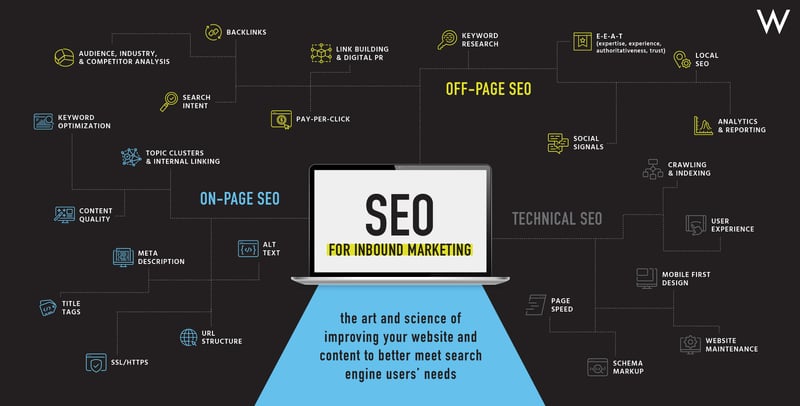Unlock the secrets of a successful SEO strategy and take your website to the top with this step-by-step blueprint!

Image courtesy of via DALL-E 3
Table of Contents
Introduction: What is SEO?
Search Engine Optimization, or SEO for short, is like a magic spell that helps websites appear at the very top when you search for something on the internet. Imagine you have a secret treasure map, and SEO is the key that helps others find the treasure, which in this case is your website!
Understanding SEO
SEO works like a superhero for websites, making them shine bright and easy to find for people who are looking for specific information. It’s like having a special superpower that helps your website stand out in a crowd of other websites on the internet.
Why SEO Matters
Businesses and individuals care a lot about SEO because the more people who visit their website, the more successful they can be. When a website is easy to find through search engines, it can attract lots of visitors who are interested in what the website has to offer, like cool videos, awesome games, or helpful articles.
Step 1: Keyword Research
When you search for something online, you type in specific words to find what you’re looking for. These words are called keywords. In the world of websites and the internet, using the right keywords is crucial to making sure people can easily discover your content. This is where keyword research comes into play.
Finding Popular Keywords
Imagine you have a blog about cute puppies. What do you think people might search for when looking for adorable dog pictures? You can use tools like Google Keyword Planner to help you figure out the words and phrases people are typing into search engines. By understanding these popular keywords, you can tailor your content to match what people are searching for, making it easier for your website to be found.
Using Keywords Correctly
Once you’ve identified the keywords relevant to your content, it’s essential to use them strategically. One key place to include keywords is in your website’s meta tags and within the alt text of images. Additionally, incorporating keywords naturally into your headlines, subheadings, and throughout your content can help search engines recognize the relevance of your website to specific search queries. By using keywords correctly, you increase the chances of your website showing up in search engine results when people look for information related to your content.
What is Quality Content?
Quality content is like a delicious pizza – everyone wants a slice! When we talk about quality content for a website, we mean writing that is helpful, interesting, and easy to read. Just like how you enjoy your favorite book or TV show, good website content keeps visitors engaged and coming back for more.
Tips for Writing
Now, imagine you’re crafting a magical spell with your words – each word you choose has the power to attract visitors to your website. Here are some simple tips to sprinkle some magic into your writing:
1. Use simple language that everyone can understand, just like explaining things to a friend.
2. Break up your content into short paragraphs and use headings to make it easy to read.
3. Include keywords naturally in your writing to help search engines find your website.
Remember, the secret sauce to quality content is to write for your audience – be helpful, be clear, and be engaging!
Step 3: On-Page SEO Techniques
Titles and headings are like the signs and labels on a map that help you find your way around. In the world of websites, titles and headings are crucial for both visitors and search engines. When you use titles and headings on your website, it helps organize your content and makes it easier for people to understand what each section is about. But that’s not all; titles and headings also play a role in SEO by letting search engines know what your page is talking about. By including relevant keywords in your titles and headings, you can improve your website’s chances of showing up in search results when people look for those keywords.

Image courtesy of texta.ai via Google Images
Meta Tags and Alt Text
Meta tags and alt text may sound fancy, but they serve a simple yet important purpose in the world of SEO. Meta tags are like hidden clues that you can give to search engines about what your webpage is all about. They provide a brief description of your page’s content and include keywords that can help search engines understand and categorize your website better. Alt text, on the other hand, is a short description of an image that appears when the image cannot be loaded. This text not only helps visitors who cannot see the images but also helps search engines “see” your images better. By optimizing your meta tags and alt text with relevant keywords, you are giving your website an extra boost in the SEO game.
Off-Page SEO Techniques
When it comes to SEO, it’s not just about what’s on your website but also what happens outside of it. Off-page SEO techniques focus on improving your website’s visibility and credibility through activities that occur off your site. Let’s explore some effective off-page strategies that can help boost your website’s search engine ranking.
Building Backlinks
Backlinks are like upvotes for your website. They are links from other websites that point back to your site. When reputable websites link to your content, search engines see it as a vote of confidence, and this can improve your website’s authority and visibility. The more high-quality backlinks you have, the better your chances of ranking higher in search results.
Using Social Media
Social media platforms are not just for connecting with friends and sharing funny memes; they can also be powerful tools for boosting your website’s SEO. By sharing your content on social media platforms like Facebook, Twitter, and Instagram, you can increase your website’s visibility and drive more traffic. The more people share and engage with your content on social media, the more likely it is to be seen by a wider audience, which can ultimately lead to more backlinks and higher search engine rankings.
Step 5: Measuring Success
After implementing various SEO strategies on your website, it’s essential to measure their success. This step helps you understand what’s working well and what might need improvement. Let’s explore how you can track the effectiveness of your SEO efforts.

Image courtesy of texta.ai via Google Images
Using Analytics Tools
Analytics tools are like magic windows that show you how many people are visiting your website and how they found it. One popular tool for this is Google Analytics. It can tell you which pages on your site are getting the most visitors, where your visitors are coming from, and even how long they stay on your site. By using these tools, you can see if your SEO strategies are bringing in more traffic to your website.
Understanding Traffic
When you look at the numbers from your analytics tools, it’s essential to understand what they mean. For example, if you see that more people are visiting your site after you started using specific keywords, that’s a good sign that your SEO strategy is working. If you notice that social media posts are bringing in a lot of traffic, it means sharing your content on social platforms is helping. By analyzing these numbers, you can make informed decisions on how to improve your SEO tactics further.
Keeping Up with Changes
Search engines like Google update the way they find websites to make sure they show the most helpful and relevant results to people. Imagine if you searched for “best pizza near me” and got results for shoe stores instead! That wouldn’t be very useful, right? So, these changes help keep search results accurate and up-to-date.
Staying Informed
If you want your website to stay at the top of search results, it’s essential to keep learning about SEO and adapt your strategies as needed. You can join online forums, read articles, or even take courses to stay up-to-date with the latest SEO trends. By staying informed, you can make sure your website continues to attract visitors and grow.
Conclusion: Building a Strong SEO Strategy
Creating a successful SEO strategy is like building a roadmap for your website to get noticed in the vast world of the internet. By following the steps we’ve discussed, you can pave the way for more visitors to discover your website and boost your online presence.

Image courtesy of www.weidert.com via Google Images
Recap of the Steps
To recap, let’s remember the key components of a winning SEO strategy:
Keyword Research
Start by finding the right keywords that people use when searching online. These words are like signposts that guide search engines and users to your website.
Quality Content Creation
Writing engaging and helpful content is vital. Remember, the best way to attract visitors is by offering value through your website content.
On-Page and Off-Page SEO Techniques
Optimize your website by using proper titles, headings, meta tags, and alt text. Additionally, build backlinks and promote your content on social media to increase your website’s visibility.
Measuring Success
Use analytics tools to track your website’s performance and understand how visitors find and interact with your site. Monitoring these metrics can help you refine your SEO strategy for even better results.
Keeping Up with Changes
Search engines are always evolving, so staying informed about the latest trends and algorithm updates is crucial. By adapting your SEO strategies accordingly, you can ensure your website remains competitive in the online landscape.
By implementing these steps and continuously refining your approach, you can build a robust SEO strategy that drives traffic to your website and sets you up for success.
Want to turn these SEO insights into real results? Seorocket is an all-in-one AI SEO solution that uses the power of AI to analyze your competition and craft high-ranking content.
Seorocket offers a suite of powerful tools, including a Keyword Researcher to find the most profitable keywords, an AI Writer to generate unique and Google-friendly content, and an Automatic Publisher to schedule and publish your content directly to your website. Plus, you’ll get real-time performance tracking so you can see exactly what’s working and make adjustments as needed.
Stop just reading about SEO – take action with Seorocket and skyrocket your search rankings today. Sign up for a free trial and see the difference Seorocket can make for your website!
Frequently Asked Questions (FAQs)
What is the Most Important Part of SEO?
When it comes to SEO, the most crucial parts are your content and keywords. Content refers to the information, articles, and pictures on your website. Good content that is easy to understand, helpful, and relevant to what people are searching for can make a big difference in how well your website ranks on search engines. Keywords are the words and phrases that people type into search engines to find what they’re looking for. Using the right keywords in your content can help search engines like Google connect your site with the right audience.
How Long Does it Take to See Results?
SEO is like planting a seed and watching it grow into a tree. It takes time and care. Results from SEO efforts don’t happen overnight; it’s a gradual process. It might take a few weeks or even months before you start seeing significant improvements in your website’s visibility on search engines. It’s all about being patient and consistent with your SEO strategies to see the best results over time.







